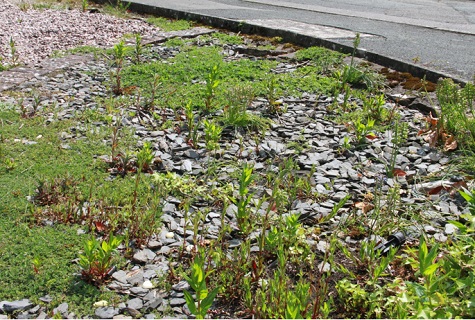The recent warm sunny days have initiated a lot of weed growth, seen in both natural grass playing surfaces, but more of a problem when they appear in other surfaces such as roads, road verges parks and playing fields - not to mention, paths, car parks, railway lines, gardens and building sites.
Weeds can be prolific and cause damage to infrastructures such as paths, roads, rail networks and buildings - especially when they are not managed.
By definition a weed is a plant that is growing in the wrong place. Weeds take valuable space, water, sunlight and nutrients that may otherwise be accessible to important crops, in our case turf grasses. Weeds not only compete for these resources they can disfigure and cause problems to playing surfaces.

Weeds are good competitors and take advantage of any opportunities to colonise turf situations, particularly when the sward is under stress and weak, leaving bare soil areas for weeds to populate.
Weeds have many mechanisms and characteristics that enable them to do this, having thick waxy cuticle leaves that can be resistant to some chemicals, fast reproduction methods, the ability to reseed in six week cycles and deep tap roots enabling the weed to survive in compacted dry ground conditions.

Weeds have one of three life cycles: annual; biennial or perennial.
Annual weeds: Live for a single season. These weeds germinate from seed in the spring or summer, flower and then die.
Biennial weeds: Live for two seasons. During the first growing season, these weeds remain in a vegetative stage and, in the following year, produce flowers, set seed and die.
Perennial weeds: Live for multiple seasons and flower more than once. Perennial structures (rhizomes, stolons, crowns, entire plants or roots) survive from year to year.
We now have a plethora of methods both chemical and mechanical to control weeds in given environments. A booklet produced by Pesticide Action Network is a good read and offers several methods of weed control.
Reducing weeds
A recent conversation with Chris Falkner of Kersten Sweepers enlightened me on the work being undertaken to reduce the number of weeds in our urban community environments. Chris stated that a weed prevention strategy should be included when considering best practice for an Integrated Pest Management approach.

All weeds (plants) require light, food and water to survive. - remove any one of these and a plant will suffer. In general, soil or detritus is a medium which stores the water and food for a plant.
Soil is not an intended constituent of a hard surface. Therefore plants do not grow on hard surfaces!
However, we know that plants may be found growing on or in hard surfaces. Therefore soil must be on or in the hard surface.
Causes of this include:
- Soils migrating from adjacent organic surfaces
- Soils being formed from detritus remaining on the surface
- Broken and unsealed hard surfaces allowing soil pockets or access to soil layer below hard surface

If we use a chemical herbicide or any other method to simply kill the plant the causes remain, and regrowth is inevitable.
However, if we remove the soil and, importantly, the cause of the soil, we short circuit the cycle.
Statutory provision is made for this in The Environmental Protection Act 1990 which imposes duties under section 89(1) and (2) on certain landowners and occupiers to keep specified land clear of litter and refuse, and on local authorities and the Secretary of State to keep clean public highways for which they are responsible.
Code of practice on litter and refuse published by DEFRA April 2006 and modified 2019 Part 1 Section 5 lists detritus as refuse and litter and must be removed from the highway under section 89 of the act and recommends detritus should be removed from all other hard surfaces as well.
Chemicals have their place, but they have been hijacked to cover the cracks in our pavements. Prevention is often better than a cure, therefore we must look at programmed effective maintenance regimes to reduce this unwanted weed growth .
If we are going to pave over nature, then surely we have a responsibility to maintain that paving in a sustainable manner. If we can't afford to maintain it, then the question is, should we build it?
The greater the depth of soil available to the weed, the greater chance of allowing deeper rooted perennial weeds to establish themselves.
Deep rooted perennials are far more difficult to kill once established.
Shallower soil will only sustain annual weeds which are easier to control with methods such as heat or sweeping. A maintenance specification may be designed to prevent detritus from building up on hard surfaces. This not only requires thought for the surface but also the surrounding environment which may affect the surface.
The picture below shows overgrown vegetation overhanging the path which is resulting in a massive detritus build up. This is blocking drainage channels, feeding the soil build up and providing ideal damp, nutrient rich conditions for weeds to thrive.

In this case the surface maintenance could start with the reduction of overhanging vegetation and fence maintenance. Robust path edgings with a simple method of maintaining those edges should be employed.
Chris has written a number of weed management articles that can be read here as well as a booklet here.